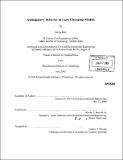| dc.contributor.advisor | Moshe E. Ben-Akiva. | en_US |
| dc.contributor.author | Rao, Anita (Anita Anant) | en_US |
| dc.contributor.other | Massachusetts Institute of Technology. Dept. of Civil and Environmental Engineering. | en_US |
| dc.date.accessioned | 2006-11-07T13:33:11Z | |
| dc.date.available | 2006-11-07T13:33:11Z | |
| dc.date.copyright | 2006 | en_US |
| dc.date.issued | 2006 | en_US |
| dc.identifier.uri | http://hdl.handle.net/1721.1/34602 | |
| dc.description | Thesis (S.M.)--Massachusetts Institute of Technology, Dept. of Civil and Environmental Engineering, 2006. | en_US |
| dc.description | Includes bibliographical references (p. 118-120). | en_US |
| dc.description.abstract | Actions performed by drivers in case of lane changing behavior are usually the result of some plan the driver has in mind. This involves anticipating future scenarios and persisting in order to execute the plan. The objective of this thesis is to develop a framework for modeling the lane-changing behavior that captures the anticipatory behavior of drivers. Two ways of capturing this behavior - a dynamic programming model and an explicit forced merging model - are developed in this thesis. The fact that drivers constantly modify their plans in the light of new information, suggests the use of a dynamic programming approach, where the solution takes the form of an optimal decision rule that specifies drivers' optimal decisions as a function of their current information. A theoretical framework is developed and the advantages and disadvantages of the approach are discussed. The computational complexity of applying such a model suggests adopting an alternative approach to the problem. The explicit forced merging model captures the planning and persistent behavior of drivers. The model is essentially a gap acceptance model that explicitly captures normal and forced merging behavior of vehicles merging from the on-ramp to the freeway. | en_US |
| dc.description.abstract | (cont.) Aggressive drivers that tend to initiate forced merging persist in their plan to complete the merging process. The parameters of the model are estimated using detailed trajectory data. Estimation results show that the lane changing behavior is affected by relative speeds of the neighboring vehicles with respect to the merging vehicle, distance to the mandatory lane changing point and acceleration of the lag vehicle. They also show that the initiation of the forced merging process is dependent on unobserved driver characteristics like aggressiveness, driving experience etc. The model is statistically superior to another model estimated with the same dataset but which ignores the planning behavior of drivers. | en_US |
| dc.description.statementofresponsibility | by Anita Rao. | en_US |
| dc.format.extent | 120 p. | en_US |
| dc.format.extent | 5794922 bytes | |
| dc.format.extent | 5799914 bytes | |
| dc.format.mimetype | application/pdf | |
| dc.format.mimetype | application/pdf | |
| dc.language.iso | eng | en_US |
| dc.publisher | Massachusetts Institute of Technology | en_US |
| dc.rights | M.I.T. theses are protected by copyright. They may be viewed from this source for any purpose, but reproduction or distribution in any format is prohibited without written permission. See provided URL for inquiries about permission. | en_US |
| dc.rights.uri | http://dspace.mit.edu/handle/1721.1/7582 | |
| dc.subject | Civil and Environmental Engineering. | en_US |
| dc.title | Anticipatory behavior in lane changing models | en_US |
| dc.type | Thesis | en_US |
| dc.description.degree | S.M. | en_US |
| dc.contributor.department | Massachusetts Institute of Technology. Department of Civil and Environmental Engineering | |
| dc.identifier.oclc | 71292657 | en_US |
